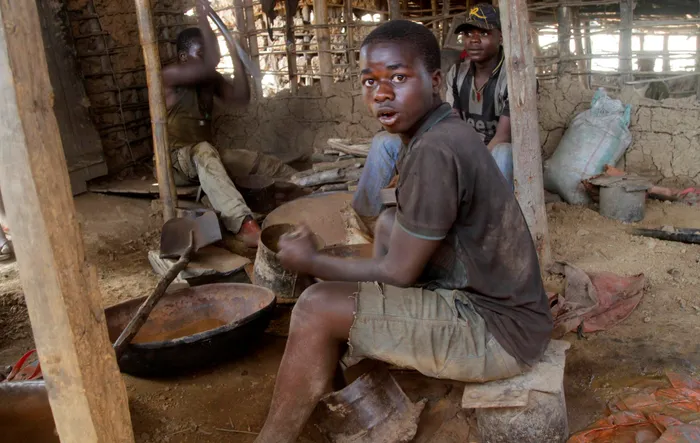Zama Zamas: ANC fails small-scale miners

Picture: Kenny Katombe/REUTERS/ taken May 10, 2014 – Artisanal miners wash soil looking for gold at the Marco mine in Mukungwe locality in Walungu territory of South Kivu, DRC. The ANC government has been aware of its responsibility to small-scale mining in South Africa since the day it took power in 1994, but has not fulfilled its task, the writer says.
By Trevor Ngwane
Lethal fumes that left 17 people, including children, dead at the Angelo informal settlement in Boksburg last week have put the spotlight again on unregulated, informal and small-scale mining in South Africa.
Dubbed zama zamas and widely condemned as “illegal” and “criminal” by the state and mining capital, this economic activity has been in the headlines for all the wrong reasons, such as the rape of eight women allegedly by illegal miners in Krugersdorp and the recent deaths of 31 miners in a Welkom mine. Is small-scale and artisanal mining necessarily a crime?
Who is to blame for the rise of zama zamas and the associated problems of this type of mining? Venomous and inflammatory vitriol against the zama zamas has arguably become a substitute for effective policies and steps needed to address the problem. Commentators and government officials, including MPs, routinely associate “illegal mining” with “illegal migration”, criminal syndicates and other crimes.
The tragedy at Angelo informal settlement is the most recent grist to the mill, with the Department of Mineral Resources and Energy announcing that it will call a conference to discuss tightening the law in the fight against illegal mining. Will another long discussion of the issue solve the problem or address the underlying causes of the scourge?
The ANC government has been aware of its responsibility to small-scale mining since the day it took power in 1994. The Reconstruction and Development Programme committed the government to transform “mining and mineral-processing industries to serve all of our people” and “to encourage small-scale mining and enhance opportunities for participation by our people through support, including financial and technical aid and access to mineral rights”.
Zama zamas are regarded as small-scale or artisanal miners. “Artisanal mining”, states the 1998 White Paper on Minerals and Mining Policy, “is meant small-scale mining involving the extraction of minerals with the simplest of tools, on a subsistence level.” The policy document goes on to affirm “small-scale” mining as a legitimate economic activity that encapsulates artisanal mining and low-capital “junior” companies. It calls for “a healthy synergy between large and small operators”.
Did the ANC do enough to support and nurture artisanal and small-scale mining? Or was it so beholden to the interests of big mining capital that it neglected its obligations to this sector? Historically, mining capital in South Africa has thrived on the super-exploitation of labour buttressed by racism and the suppression of labour rights.
The gold ore required deep-level mining and big capital outlays which the mining magnates overcame by implementing the cheap labour system whose main pillars were the migrant labour system and the flouting of health and safety standards. Black miners were paid a pittance, kept like prisoners in compounds, and their lives counted for nothing, with many dying from mining accidents and dangerous conditions underground. Black miners came from various parts of the country, notably from the villages of the Transkei such as Libode, Ngqeleni and Mqanduli.
The mines also sourced their cheap labour from other African countries including Mozambique, Malawi, Zimbabwe and Lesotho. The ANC’s commitment to rolling back the legacy of oppression and exploitation that emanated from the days of conquest, dispossession and super-exploitation surely included correcting the wrongs that were showered on these miners and their children and their children’s children – a responsibility that goes beyond our borders.
The ANC has done next to nothing to right the economic wrongs of the past. It left white monopoly capital firmly in charge of the mines and the wealth amassed through super-exploitation. It negotiated a share of the profits for a handful of ANC-connected aspirant black bourgeoisie. Patrice Motsepe owns the Harmony Gold Mining Company in charge of the Welkom mine where 31 zama zamas recently died after a methane gas explosion.
In 2009, 82 miners died in another Harmony Gold mine in Welkom after inhaling toxic gas. President Cyril Ramaphosa was a shareholder and director at Lonmin when 34 miners were shot dead by police while on a wage strike in the 2012 Marikana massacre. Thousands of jobs were lost in the gold mining sector in post-apartheid South Africa due to mine closures and production cutbacks, with working-class communities in South Africa and other parts of Africa bearing the brunt of the resultant economic calamity.
Desperation characterises zama zama operations, with men living for months on end underground in dangerous conditions where they face death daily. These workers are victims of the failure of the ANC government to make mining capital take responsibility for the harm done to African workers and communities over centuries of super-exploitation and suppression of black labour, from the days of Cecil John Rhodes to those of Harry Oppenheimer.
Their profit-mongering and neglect are ultimately responsible for the deaths at Angelo informal settlement, Welkom, Krugersdorp and other parts of the country wrecked by the capitalist system.
Trevor Ngwane is Director of the Centre for Sociological Research and Practice, University of Johannesburg